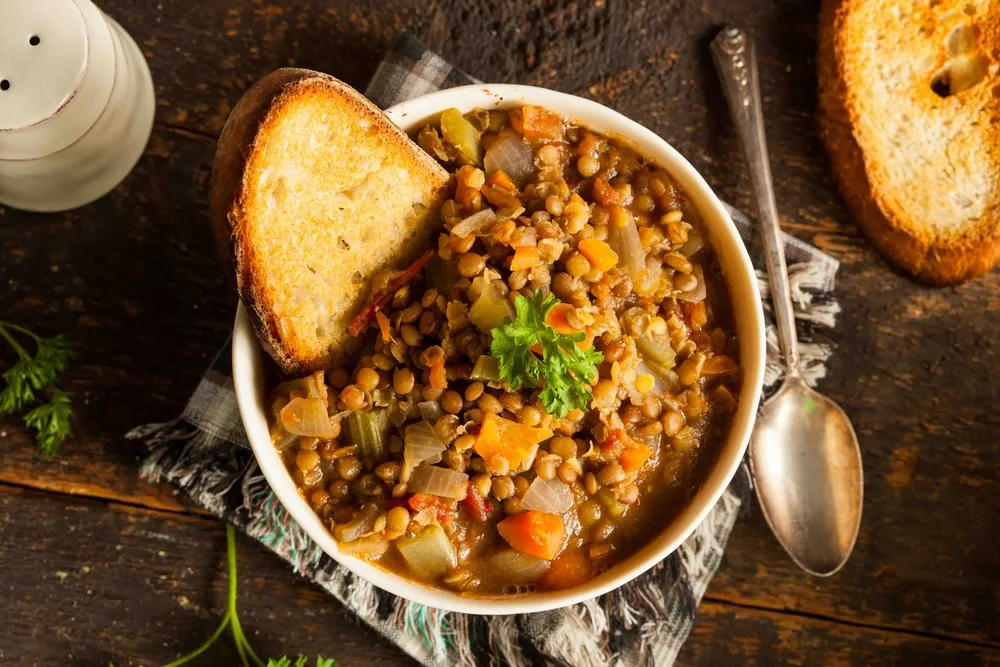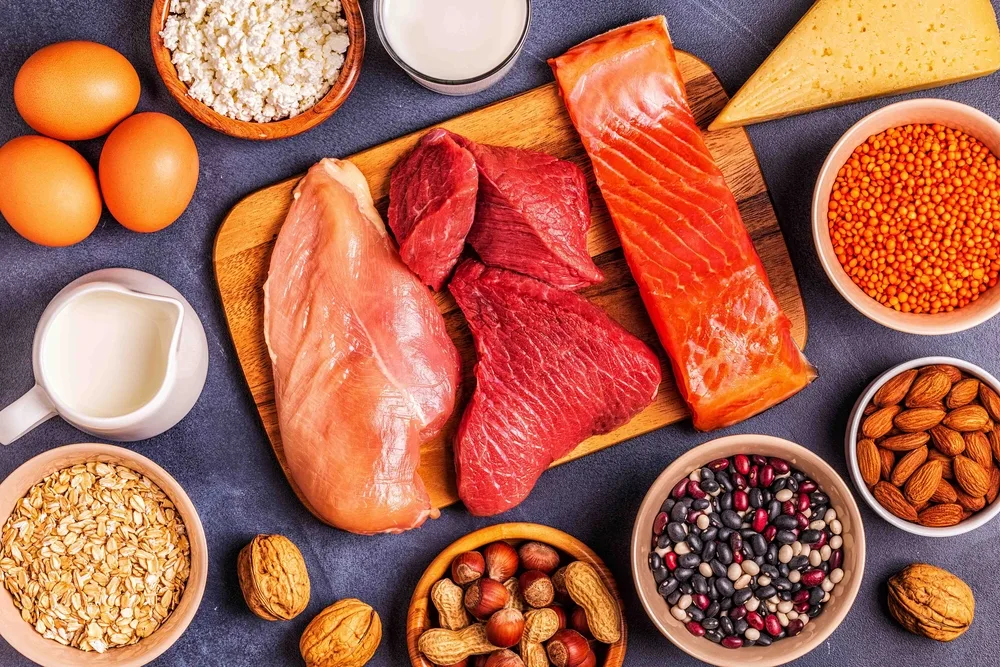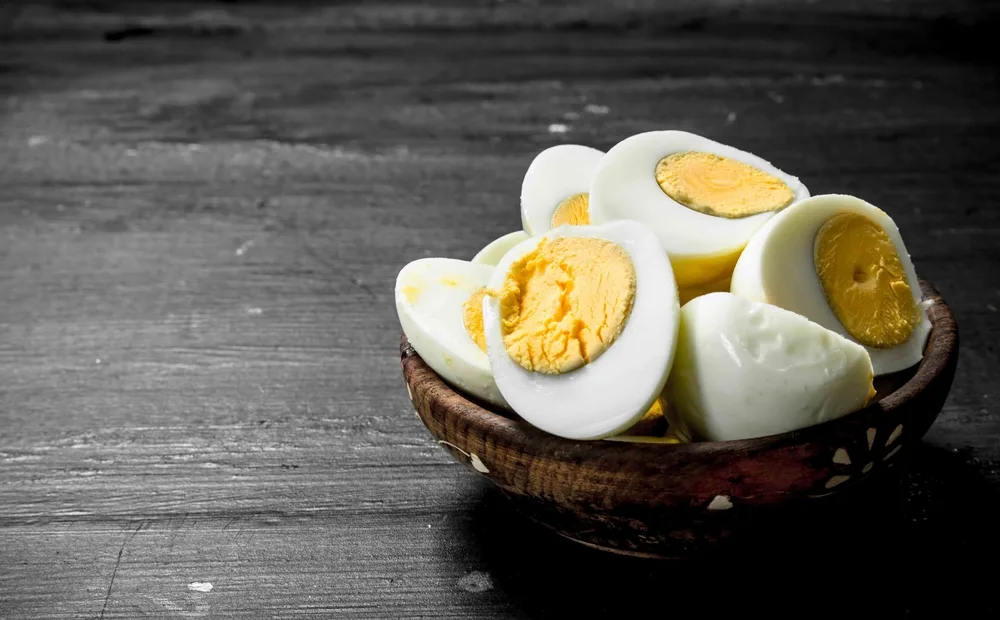How to Eat 100 grams of Protein Daily

You’ve probably seen your favorite fitness influencer going on and on about proteins and why it is a non-negotiable to hit 100 grams of protein daily. And there’s a reason. Whether you are trying to bulk up or slim down, you need proteins. There is no shortcut.
I have recently gotten into body recomposition. One of my short-term life goals is to gain lean muscle and get stronger. I am also looking to tone up and lose a little body fat. I had to really amp up my protein intake to achieve this.
At first, that number might sound pretty high. However, achieving it can be much easier with a solid plan.
In this article, you’ll find why protein intake is essential, a complete list of high-protein foods you should incorporate into your meals, and a one-week 100-gram protein-per-day meal plan.

So, Why Should You Try To Hit 100 Grams of Protein Daily?
Protein is a major macronutrient that you should be eating in every meal. It is a blocking block for muscles, joints, and other tissues. Protein is an essential structural component of enzymes and hormones in the body. Protein is also a source of energy, among a multitude of other things.
Here are some reasons protein is pretty popular right now:
How to Hit 100 Grams of Protein Daily
To reach 100 grams of protein per day, you have to spread out your intake per meal. Aim for around 20-30 grams per meal. Making sure you have protein-rich food at every meal will make it very easy to hit that number.
However, do not get caught up in the “20-30” grams per meal breakdown. The most important thing is to hit that number. When you are consistently consuming more than 100 grams of protein daily, you can start worrying about spreading it in your meals.

How Much Protein Should One Eat?
The amount of protein you need daily varies significantly depending on gender, age, body weight, level of physical activity, and overall health.
The Dietary Guidelines for Americans recommend that an adult female consume at least 46 grams of protein daily and an adult male consume at least 56 grams.
However, as you have noticed, the term used is “at least” going higher is recommended and encouraged.
Going higher is particularly important if you are physically active. Active individuals should aim for about 1.2-2 grams of protein per kilogram of body weight (that’s around 0.55- 0.90 grams per pound of body weight). For instance, a 150-pound, active adult should get 82.5- 135 grams of protein daily, which falls within our 100-gram range.
To calculate exactly how much protein you need, assuming you don’t have a sedentary lifestyle and typically try to move your body a couple of times a week. Multiply your weight in kilograms by 1.2 or your weight in pounds by 0.55. However, please note this is on the lower end. If you are very active, use the upper limit.
For instance, since I am actively in the gym lifting weights at least three times a week. I stick with the upper limit, 0.9 grams of protein per pound of body weight.
This number can go even higher if you are involved in high amounts of intense training. The recommended daily intake in this instance is 0.7 to 1.4 grams per pound of body weight.
One easy number if you are actively working out several times a week and trying to build muscle is 1 gram of protein per pound of body weight.

High Protein Food List
Please note..
Protein content per food varies depending on how it is cooked. Similarly, for animal-based proteins, protein content varies depending with the cute. For instance, lean cuts tend to have more protein quantity.
Animal-based
- Beef(sirloin steak)- 27g protein/ 100 grams/3.5oz
- Pork(Tenderloin chop)- 26g protein/100g
- Lamb- 25g/100g
- Ground beef(Grass-fed)- 14g/100g
- Bison-20g/100g
- Venison- 30g/100g
- Salmon-23g/100g
- Tuna- 28g/100g
- Cod-18g/100g
- Shrimp-24g/100g
- Scallops- 24g/100g
- Tilapia- 26g/100g
- Chicken breast (cooked)-31g/100g
- Chicken thigh( cooked) -24g/100g
- Chicken drumstick (cooked)- 18g/100g
- Chicken wing( cooked)- 30g/100g
- Ground chicken (lean)- 24g/100g
- Turkey breast- 29g/100g
- Eggs- 6g in one large egg
- Greek yogurt (Plain, non-fat)- 10g/100g
- Cottage cheese- 12g/100g

Plant-based Protein
- Lentils( cooked)- 9g/100g
- Chickpeas (cooked)- 9g/100g
- Quinoa (cooked)- 4g/100g
- Tofu (firm)- 17g/100g
- Tempeh- 19g/100g
- Edamame (Cooked)- 11g/100g
- Hemp seeds- 6g/28g or 1 oz/2tbsp
- Almonds- 6g/28g or 1 oz
- Chia seeds- 5g/28g or 1 oz
- Peanut butter- 8g/30g or 2tbsp
- Walnuts- 4.3g/28g or 1 oz
- Pumpkin seeds (Roasted)- 8g/28g or 1 oz
- Sunflower seeds( Dry roasted)- 5g/28g or 1 oz
RELATED: 36 VEGETARIAN PROTEINS YOU SHOULD BE EATING
Protein Supplements
Whey protein powder- 20-25g per scoop
Vegetarian protein powder -15-20g per scoop

7-Day Meal Plan for 100 grams of Protein Per day
Here is a simple 7-day meal plan to show you how to consume 100 grams of protein daily. I have focused on protein; feel free to sub the carbs and fats as you see fit. However, I have provided entire meals so you can actually visualize this.
Tip
I have opted to use grams since it is a more straightforward unit of measurement in this context since we are measuring the protein content in gram as well. 100 grams is around 3.5 oz, and 150 grams is around 5.2 oz.
Monday (120 Grams)
Breakfast: Scrambled Eggs with Smoked Salmon and a little Spinach
3 large eggs (18g protein)
50g smoked salmon (9g protein)
50g cooked spinach (2g protein)
Total: 29g
Lunch: Grilled Chicken with Quinoa and Veggies
150g grilled chicken breast (46g protein)
100g quinoa (cooked) (4g protein)
150g mixed veggies (broccoli, carrots, peppers) (5g protein)
Total: 55g
Snack: Cottage Cheese and Almonds
100g low-fat cottage cheese (12g protein)
15g almonds (3g protein)
Total: 15g
Dinner: Tofu Stir-Fry with Broccoli and Soy Sauce
150g tofu (firm) (17g protein)
100g broccoli (cooked) (4g protein)
Soy sauce, garlic, ginger for flavor
Total: 21g

Tuesday (126 Grams)
Breakfast: Protein Smoothie
1 scoop whey protein powder (20g protein)
1 medium banana (1g protein)
250ml( 1 Cup) almond milk (1g protein)
1 tbsp chia seeds (2g protein)
Total: 24g
Lunch: Turkey Lettuce Wraps
150g turkey breast (44g protein)
Lettuce, tomato, cucumber (1g protein)
Total: 45g
Snack: Hard-Boiled Eggs
2 large eggs (12g protein)
Dinner: Shrimp Tacos
150g shrimp (36g protein)
2 small whole-wheat tortillas (5g protein)
Black beans (50g cooked) (4g protein)
Total: 45g

Wednesday (101.5 Grams)
Breakfast: Greek Yogurt with Berries and Granola
200g plain Greek yogurt (20g protein)
50g mixed berries (0.5g protein)
30g granola (3g protein)
Total: 23.5g
Lunch: Steak Salad
150g lean steak (40g protein)
Mixed greens, cucumber, tomatoes (2g protein)
Total: 42g
Snack: Protein Bar
1 high-protein bar (20g protein)
Dinner: Lentil Soup with Whole-Grain Bread
150g cooked lentils (13g protein)
1 slice whole-grain bread (3g protein)
Total: 16g

Thursday(107 Grams)
Breakfast: Omelette with Cheese and Spinach
3 large eggs (18g protein)
30g shredded cheddar cheese (5g protein)
50g spinach (cooked) (2g protein)
Total: 25g
Lunch: Baked Salmon with Brown Rice
150g baked salmon (33g protein)
100g brown rice (cooked) (2g protein)
150g roasted veggies (4g protein)
Total: 39g
Snack: Edamame
100g cooked edamame (11g protein)
Dinner: Tempeh Stir-Fry
150g tempeh (28g protein)
100g broccoli (cooked) (4g protein)
Soy sauce, and sesame oil for flavor
Total: 32g

Friday (127 Grams)
Breakfast: Protein Pancakes
1 scoop whey protein powder (20g protein)
1 egg (6g protein)
50g oats (blended) (4g protein)
Total: 30g
Lunch: Grilled Chicken Wrap
150g grilled chicken (46g protein)
Whole-wheat wrap (5g protein)
Veggies and hummus (3g protein)
Total: 54g
Snack: Cottage Cheese with Chia Seeds
100g low-fat cottage cheese (12g protein)
1 tbsp chia seeds (3g protein)
Total: 15g
Dinner: Baked Cod with Sweet Potato
150g cod (27g protein)
100g sweet potato (1g protein)
Total: 28g

Saturday(103 Grams)
Breakfast: Avocado Toast with Eggs
2 large eggs (12g protein)
1 slice whole-grain bread (3g protein)
50g avocado (1g protein)
Total: 16g
Lunch: Chicken Caesar Salad
150g grilled chicken (46g protein)
Romaine lettuce, croutons, Parmesan (4g protein)
Total: 50g
Snack: Protein Shake
1 scoop whey protein (20g protein)
Dinner: Lentil Curry with Quinoa
150g cooked lentils (13g protein)
100g quinoa (cooked) (4g protein)
Total: 17g

Sunday (107 Grams)
Breakfast: Veggie Egg Scramble
3 large eggs (18g protein)
50g bell peppers + onions (2g protein)
Total: 20g
Lunch: Tuna Salad
150g canned tuna (in water) (35g protein)
Mixed greens, cucumber, avocado (3g protein)
Total: 38g
Snack: Edamame
100g cooked edamame (11g protein)
Dinner: Grilled Shrimp with Zoodles
150g shrimp (36g protein)
100g zucchini noodles (2g protein)
Total: 38g

Simple Tips to Increase Your Daily Protein Intake
1. Create a 100-gram protein meal plan
The most effective tip for ensuring you get at least 100 grams of protein is to create a meal plan. There are several meal plan options, from Google Sheets to journals and apps such as MyFitnessPal.
2. Add protein powder to what you can
Add some protein powder whenever you get the opportunity. For instance, you can add protein powder to your shakes, Greek yogurt, oats, and pancakes.
3. Choose leaner cuts
Choosing leaner cuts is a great way to boost your protein intake. They have a higher protein content per serving.
4. Use bone broth to cook your meals
Another simple tip to easily increase your daily protein intake is to use bone broth to cook some of your meals. Instead of using water to make rice, quinoa, or what have you, use bone broth. Each cup of bone broth you use will add roughly 10 grams to your protein intake.
5. Snack on protein-filled snacks
Keeping protein-rich snacks such as boiled eggs, edamame, and protein bars on hand is another way to easily boost your daily protein intake. This is particularly important for pre- and post-workout snacks.
6. Watch what you eat for breakfast
Many breakfast options lack enough protein. Cereals, toast, and bagels are all pretty low in protein. Even a popular and particularly healthy option like oatmeal provides a minimal amount of protein per serving—one cup of oatmeal only provides around 8 grams of protein. Make sure to include protein-rich options such as eggs in your breakfast.

7. Choose protein-rich toppings
Another simple way to increase your daily protein intake is to choose protein-rich toppings such as almonds and hemp seeds.
8. Batch-cook protein-rich foods whenever possible
Another way to increase your daily protein intake is to batch-cook protein-rich foods like chicken and lentils whenever possible. Batch cooking makes it easier to get your protein intake even when you are busy or simply tired.
Take Away
As you can see, getting 100 grams of protein per day can be much easier than you think. Try out the above recipes and tips and enjoy all the benefits of a high-protein diet, including gaining and maintaining muscle, controlling appetite, and losing weight.